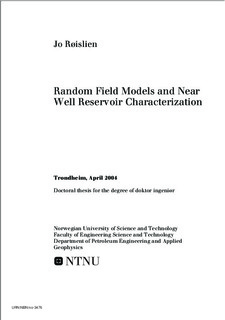| dc.description.abstract | In Part 1 T-distributed random fields (TRF) are adressed. The main contribution of this paper is the introduction of a new, analytically tractable, heavy-tailed continuous random field model, namely the TRF model. In Gunning (2002) a related random field model is discussed. Based on a motivating example from a well log from the Gullfaks field in the North Sea, it is demonstrated how the T-distribution is able to describe the variability in the geophysical data better than the frequently used GRF model. This flexibility is obtained by introducing a new parameter, the degrees of freedom. The qualities of TRFs are defined in detail, together with results for hiearchical representations, simulation and estimation of model parameters. It is shown that the TRFs are analytically tractable, with several properties equal, or similar, to the GRF. Also, the TRF includes the GRF as a limiting case when the degrees of freedom parameter goes to infinity. The heavy-tailed effect is observable only cross-realization, and not in-realization, implying that several independent realizations of the random field is needed in order to formally estimate the degree of freedom parameter. Both the TRF and GRF models are estimated on a real well-log observations from the Gullfaks field, and the TRF model appears to be superior to existing Gaussian-based models, as well as L´evy-Stable random field models.
In Part 2 inversion of well log observations and seismic data is performed. The goal is the elastic parameters, P-wave velocity, S-wave velocity and density. The main contribution of this paper is that a spatially continuous approach is used in the inversion, allowing the information to be included in their exact spatial locations, not having to be forced into a grid representation. Also, scaling differences between well log observations and seismic data are implicitely taken care of. The paper is an extension of parts of the work done by Buland and Omre (2003). A priori, the the elastic parameters are defined as a log-Gaussian random field. This results in a posterior distribution for the log of the elastic parameters being approximately a continuous Gaussian random field. Thus, the result of the inversion is analytically available when performing a linearization of the well log observations. As the posterior pdf is given on a spatially continuous form, grid refining is easy. Also, prediction in any arbitrary location can be performed.
In Part 3 the problem of discretizing continuous random fields is adressed. The main contribution of this paper are general formulas for representation of any random field, by any set of basis functions. Assume a reparameterization of a continuous random field through a given set of spatial basis functions, and a corresponding set of random parameters. That is, the continuous spatial random field is split into a continuous spatial part, and a stochastic part. It is demonstrated how the stochastic properties of the continuous random field are inherited by the discrete set of random parameters, given the set of spatial basis functions. The results are demonstrated for different sets of basis functions, both orthogonal and non-orthogonal. Wavelet bases and results for GRFs are studied in more detail. See Walter and Shen (2001) for more on orthogonal systems.
In Paper 4 a data analysis on synthetic production data genereated from a percolation system is performed. The main contribution of this paper is the demonstration of to which extent the knowledge of the breakthrough time increases precision in forecast of oil production. This is done by estimation of the two first moments. Clear trends in the behaviour of the empirical mean and variance, when conditioning on different breakthrough times, are observed. This suggests that there might exist general results being independent of the given percolation system. The two first moments are also introduced into a more formal statistical setting; as parameters in a Gaussian distribution. This can be used to quantitatively compare conditional and unconditional production data, and thus quantifying the increased knowledge of future oil production the breakthrough time provides. See Stauffer and Aharony (1992) for an introduction to percolation theory.
In summary, Parts 1-3 contains the core of the thesis, focusing on near-well description of reservoirs, and the modelling of elastic material parameters as continuous random fields.
Part 2 applies the frequently used continuous GRF model in a Bayesian inversion procedure, resulting in an analytical, continuous GRF posterior distribution for the elastic material parameters given both well log observations and seismic data. However, it is a well-known fact that the GRF model is not capable of explaining all the variability in geophysical measurements. Part 1 introduces a new analytically tractable, continuous random field model with a more heavy-tailed pdf, the TRF model. When working with continuous random fields, at some point a discretization must take place. Part 3 adresses the problem of discretizing continuous random fields given a set of basis function. Results for any random field in general, and GRFs in particular, are provided. Finally, Part 4 is an empirical study of synthetic production data generated from a percolation system. It thus differs from the first three parts in several ways, mainly in fact that the full field is considered, and that continuous random fields is not the main concern. | nb_NO |
